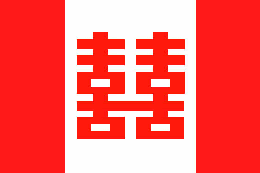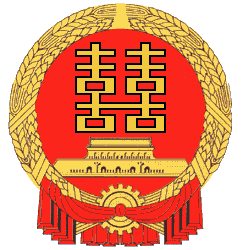The Xheng Federation
The Xheng Federation is the successor state to the Arch-Imperium of The Xheng Dynasty. It a federation of 10 provinces.

| |
| Flag of The Xheng Federation | |
| Motto: With Heaven's Blessing | |
| No Map Available Yet | |
| Region | Europa |
|---|---|
| Capital | Xi'an |
| Official Language(s) | English, Chinese, |
| Leader | His Imperial Majesty the Xheng Emperor |
| Population | 11.3 Billion |
| Currency | Imperial-Euro |
| NS Sunset XML | |
Contents
The Dynasty
The Imperial Family, the Xheng Dynastic line still holds the official role of a royal family and heads of state. The Xheng Emperor himself is the formal head of state of the nation and in practice and protocol, everything his ministers do, is in in his name and officially his decision but in practice as a constitutional monarchy the true power is within the government itself. The Dynasty has no true political powers anymore ever since The Peaceful Revolution.
See main article, see History of the Xheng Dynasty
The Federation
</div>The Federation is composed of 10 provinces. These provinces share certain responsibilties such as tax collecting with the Federal Government. A significant portion of the Federation is also immigrants who are seen as equal citizens upon achieving citizenship. The Federation also has the central federal government that has constitutional responsibilties some shared some unique. The Federal Government oversees the most important ministries such as foreign relations and parliamentary supremacy.
</div>The Federation itself has little to do with direct spending in terms of Enviornmental policies, Social Welfare, or Public Transportation. Instead these are actually delegated towards State Owned Enterprises. Since State Owned Enterprises themselves are technically self-responsible corporate entities, their budgets and such are not disclosed as Government Funding and administative costs, which is why they don't show up as government records. Within the Imperial Stratagem's laws, there is little disclosure even with State Owned Enterprises. However it is suspected that mega conglomerates such as Dynastic International, PetroEnerGen, Imperial Networks and Royal Star Enterprises spend heavy funds within these areas. Dynastic International in particular is extremely well known for spending vast sums of its profits in supporting enviornmental causes. PetroEnerGen itself is under heavy scrutiny, as it is a PetroChecmical Corporation, to assure that the enviornment is well looked after. Royal Star Enterprises and Imperial Networks oversee the majority of the transportation costs since there is a vast need for effective public used transportation systems. The Octopus Card, was one of the many systems used to support public transport.
Commerce
The Commercial structure of the Xheng Dynasty is quite complex with a number of Government owned corporations and Dynastic Companies that have dominance over their capitalist market. For a Monarchy, the Arch-Imperium is extremely socialist which is shown by icons like the Red and Yellow Star.
The construction of the Xheng-Class Worldships was a breakthrough for manufacturing of large scale vessels and construction projects. The technology required to create such huge vessels was put to later use when the construction of cities took priority. At an astounding rate cities throughout the Arch-Imperium's territory were springing up with fully functional facilities. Hydroelectric, solar and wind power were used to make the entire region enviornmentally friendly. Geothermal energy sometimes was also exploited to be used for heat generation. The need for energy sources allowed the enviornment to be targetted but the government was adamant that the enviornment was a definate issue that could not be disputed. As a result the Arch-Imperium has some of the most strict laws regarding enviornmental protection.
Cities made of steel and glass seem to be the more popular but also other construction materials like concrete and wood and even bamboo are common place. A mixture of their ancient curved roof architecture and compacted earth may still be seen in the building of traditional gardens and temples. For the most part modern grey and glass structures are more common. To allow for beauty, asthetic appeal is of pivotal importance. Gardens and plantlife of various colour variations are highly favored.
The Xheng Dynasty itself owns many large corporations which are highly profitable. These companies are not under the jurisdiction of the government executive, rather under the royal family of the Xheng Dynasty.
See main article, see Commerce of the Xheng Dynasty
Media
Much like Dynastic International, The Xheng Dynasty holds a formidable share of the Media as well, this includes news programs, newspapers and magazines, web blogs, internet news sites, and mass media broadcasts. Under the megacompany Imperial Telecommunications (Imperial Telecom) a massive share of all the media types are all under the majority control of the government. The sheer influence of the media power of Imperial Telecom reaches all of the households throughout the Arch-Imperium at the same time Government and Royal Funding keeps the company flourishing with a massive job market constantly growing for the spread of news. Imperial Telecom is seeking to break into neighboring markets.
The largest news network is the Xheng Imperial News Distrbution Agency, better known as XINDA.XINDA runs 24 hours, 7 days a week always with updated reports on issues that concern citizens on everytopic imaginable. The XINDA network is a subsidiary of Imperial Telecom but bears the Xheng name as they have ownership over the Agency itself. XINDA has a strict protocol for objectivity and even though the Xheng dynasty has ownership they do not interfere with the news services itself. XINDA by far is the largest of the news agencies but is not alone, however it is the only one that is half publically owned.
See main article, see XINDA
The Imperial Stratagem (government structure)
</div>The government forumula of the Xheng Dynastic Arch-Imperium is consisted of three legislatures the executive, the royal family and the Judicial system. Throughout the system of government representatives are elected by a democratic process similar to those of European Nations but they utilize a single-transferable ballot proportional representation system. By tradition the legislative system is refered to as the Imperial Stratagem.
The legislative process in the Imperial Stratagem is relatively simple. There are three readings in every chamber. Every reading must pass with a majority then it is immediately moved to the next chamber. All legislation can be introduced by any member of any hall or council, but it must begin in the Hall of Deputies. The Hall of Deputies represents the majority of the general public so that is the beginning of any process. Amendments can be made in each of these processes including committees which are made as a stage 2 of the readings.
See main article, see Government of the Xheng Dynasty
Arch-Imperium Military Defense Forces
The establishment of the Arch-Imperium Military Defense Forces was a direct order from the Emperor, the Imperial Proxy and the Prime Minister. The Military Forces were created at the same time as Psionex, at first a privately owned military hardware manufacturer that later evolved into the prime military supplier and manufacturer for the entire Arch-Imperium. At first the logistics of supporting the estimated size of the needed military was exponetial but tax rises and reliance on more automated techniques in technology and resource extraction efficiency allowed for the growth and sustainment of a substantial military presence.
The growth of the Imperial Military was fast and it was intense. Over the course of 10 years, the army quadrupled in size and naval vessels were pouring out of shipyards with blazing speed. The effectiveness of the military experience was proven in a series of wargames and simulations but the military had no need yet to engage in actual armed combat against an enemy nation. The AIMDF was designed to be defensive, guarding the floating cities and Worldships of the Arch-Imperium.
The military philosophy of the Arch-Imperium follows a simple phrase "quality over quantity". They didn't want their military to bear the paper tiger reputation as a large but ineffective beast. Every single soldier is trained to the maximum efficiency allowing for unrivaled performance and equipment is state-of-the-art. Obselete equipment is quickly replaced with higher value and better versions of technology that would be of benefit in the field as well as in practice and drills.
To this extent, the Imperial Stratagem has delegated huge sums of money towards the military services. This puts the Arch-Imperium's armed forces into a high-tech fighting machine and digital technology, satelite systems and other technology help them achieve their goals.
See main article, see Military of the Xheng Dynasty
Political Parites
- Union Socialist Party
- Progressive Party
- Liberal Democratic Monarchist Coalition
- Conservative Alliance
- Traditionalists Party
Special Economic Zones
To increase foreign investment into the Arch-Imperium, the Imperial Strategem setup a number of Special Economic Zones (SEZ's) to encourage a massive income of money from other nations. These SEZ's are famous for massive tax breaks towards international companies and foreign governments making their land also highly valued. The floating cities are examples of these are are even the large Dynastic-Class Worldships. Though the Worldships are not interpreted as foreign territory, they are under the jurisdiction of the Imperial Stratagem itself.
To allow the concentration of wealth to be more stable, the Xheng Dynastic Territories have been added to this tax exemption district, making the lands surrounding the capital city of Xian a massive tax break area. It is here that many foreign companies setup offices and luxury resorts to cater to their wealthy customers.
Territories
The Arch-Imperium is made up of one main territory, and eight Imperiums. Each Imperium is in truth a sovereign nation which owes greater allegiance to the Arch-Imperium which is ruled by the Xheng dynasty. Under the authority of the Xheng Emperor, the Imperiums have their own domestic matters to attend to aside from defense and foreign affairs.
- Li-Xheng
- Han-Xheng
- Sui-Xheng
- Tang-Xheng
- Han-Xheng
- Qin-Xheng
- Xia-Xheng
- Wong-Xheng
- Ming-Xheng: Independent overseas territory
- Shang-Xheng: Pseudo-Independent Principality
Capitals
- Arch-Imperial Capital
- Population: 17 million
- Imperial Capital
- Population: 5 million
- Imperial Capital
- Population: 7 million
- Imperial Capital
- Population: 6 million
- Imperial Capital
- Population: 4 million
- Imperial Capital
- Population: 3 million
- Imperial Capital
- Population: 9 million
- Imperial Capital
- Population: 8 million
Municipalities
- Municipality
- Population: 4 million
- Municipality
- Population: 4 million
- Municipality
- Population: 5 million
- Municipality
- Population: 6 million
- Municipality
- Population: 6 million
- Municipality
- Population: 3 million
- Municipality
- Population: 4 million
- Municipality
- Population: 7 million
Landmarks
- Saja Castle
- The Imperial Palace
- Kojun Temple
- Dynastic International HQ
- Kowloon harbour
- The Dragon Teeth Valley
- Imperial Telecom TV Tower
- Jade Tower
Links
See also:



